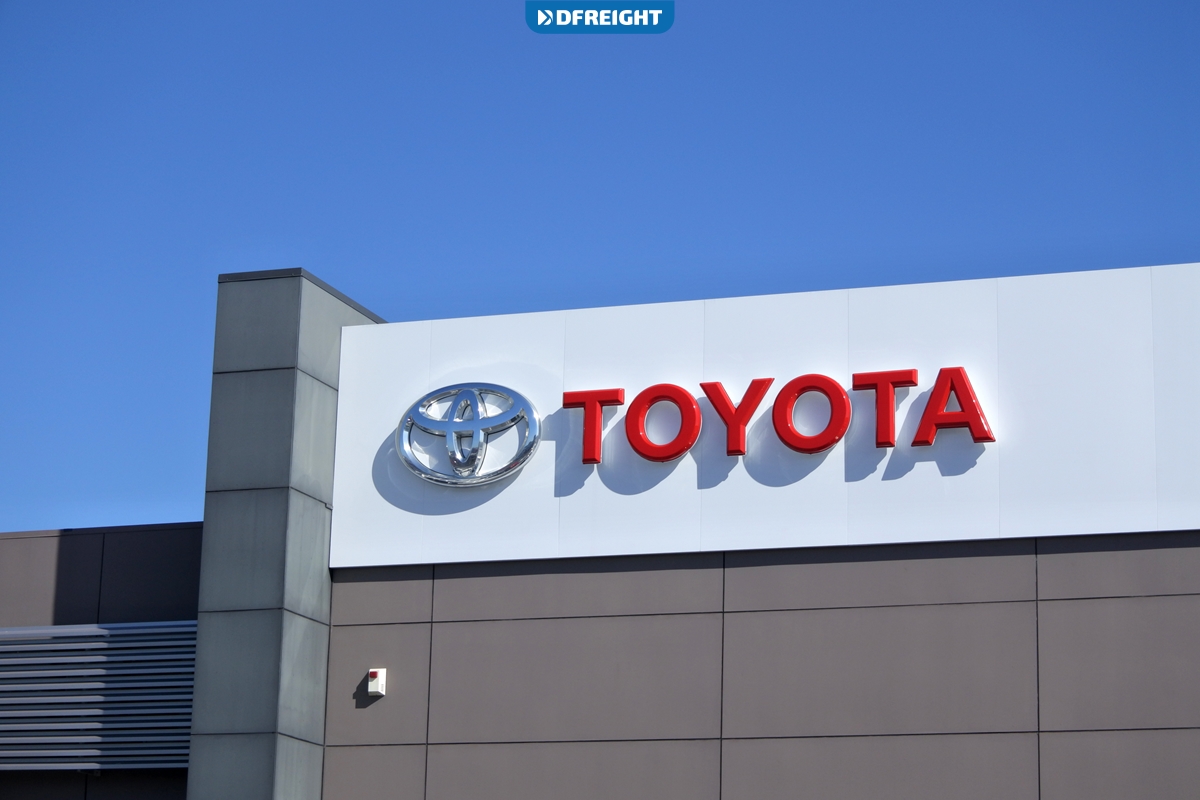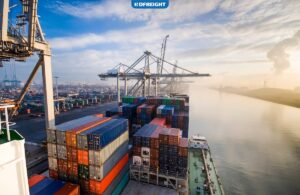Toyota is a leading automotive manufacturer with a well-developed and highly efficient supply chain strategy. Over the years, Toyota has developed a successful supply chain strategy that has enabled it to become one of the most successful companies in the automotive industry. In this blog post, we will explore the background of Toyota supply chain strategy and the evolution of the strategy.
We will also discuss the importance of a successful supply chain strategy for other businesses and the lessons that can be learned from Toyota’s supply chain strategy. By the end of this blog post, readers will have gained an insight into Toyota’s supply chain strategy and how it has helped the company become one of the world’s leading automotive manufacturers.
If you’re looking for a reliable and efficient digital freight forwarder, look no further than DFreight! Our platform simplifies the freight forwarding process, offering a range of features that make it easier and faster to ship your products. Sign up today and experience the power of digital freight forwarding!
Table of Contents
Toyota Supply Chain Strategy
The Toyota Motor Corporation is a globally recognized leader in the automotive industry. From its beginnings in 1937, Toyota has established itself as a leader in supply chain management and production process innovation. Toyota’s supply chain strategy has been instrumental in its success and has allowed the company to achieve a level of competitive advantage over its competitors.
Toyota forecast operating profit would rise to 3.0 trillion yen ($22.2 billion) this business year, in line with an analysts’ average forecast of 3.02 trillion yen.
REUTERS
Toyota supply chain strategy has evolved significantly over the years in response to changing market conditions. Here are the key components of Toyota supply chain strategy, which has allowed the company to maintain its competitive advantage.
- The first element of Toyota supply chain strategy is the close relationships it has built with suppliers. Toyota has been able to create strong, mutually beneficial links with its suppliers. This has allowed the company to maintain control over its supply chain and ensure that it is able to access the necessary components and materials it needs to produce its vehicles.
- The second element of Toyota’s supply chain strategy is its focus on quality. The company has implemented a number of initiatives to ensure that the components and materials it sources are of the highest quality. This includes the use of quality control inspection processes at all stages of the production process. This ensures that the company is able to produce vehicles of the highest quality.
- Thirdly, Toyota has adopted a global approach to supply chain management. This has allowed the company to access the best suppliers from around the world and ensure that the materials and components it uses are of the highest quality. This globalization of the supply chain also enables Toyota to take advantage of cost savings and economies of scale.
- Finally, Toyota has implemented a number of initiatives to ensure that its supply chain is as efficient as possible. These initiatives include the use of just-in-time production methods to reduce inventory levels and reduce costs. The company has also implemented a number of technologies such as RFID tracking systems to help manage its supply chain better.
In conclusion, Toyota’s supply chain strategy has been instrumental in helping the company maintain its competitive advantage. The company has built strong relationships with its suppliers, maintained a focus on quality, adopted a global approach to supply chain management, and implemented a number of initiatives to ensure that its supply chain is as efficient as possible. This strategy has allowed the company to remain a leader in the automotive industry.
In the previous blogs, we looked into the supply chains of famous and leading companies, which you can read about each of them in the section below.
| Tesla | BMW |
| Nike | Honda |
| Apple | H&M |
| Intel | Cisco |
| Amazon | Zara |
| Adidas | Costco |
| Samsung | KFC |
| ADNOC | Walmart |
| Coca-Cola | L’Oréal |
| McDonald | Pepsi |
| Unilever | Schneider Electric |
| Nestle | IKEA |
| Starbucks |
Lean Manufacturing System
The company’s supply chain strategy is also based on a concept called “lean” production. Lean manufacturing is a process optimization approach that focuses on eliminating waste and improving efficiency in order to maximize value for customers. This approach has been applied to the Toyota supply chain strategy in a variety of ways, including the use of Just-in-Time (JIT) production and inventory management, reducing costs through lean production, and improving customer service.
The Pull System
The Pull System is designed to reduce production lead times, thereby increasing manufacturing efficiency and reducing waste. Toyota uses the Pull System to control inventory levels, reduce production costs, and ensure customers receive their orders on time.
The main concept behind the Pull System is the idea of “pulling” products from the production line only when there is actual customer demand for them. The Pull System does not produce products in advance but rather waits until a customer places an order and then “pulls” the necessary components and materials to build that specific product. This helps to reduce a large amount of inventory since only what is needed is produced.
Another key benefit of the Pull System is that it enables Toyota to produce smaller batches of products for customers. With the Pull System, Toyota can produce a specific batch of products for a particular customer, thus ensuring that the customer receives exactly what he or she ordered. This helps to reduce production costs since Toyota does not have to produce large batches of items that may not be sold.
The Pull System is also beneficial for customers since it reduces the amount of time it takes for them to receive their orders. The Pull System eliminates the need for long lead times since customer orders are processed as soon as they are received. This is beneficial for customers since they do not have to wait for their orders to be fulfilled.
Overall, the Pull System is an effective way for Toyota to reduce production costs, inventory levels, and lead times. The system helps Toyota to produce smaller batches of products for customers and ensure they receive their orders on time. The Pull System is an important part of Toyota’s success and has enabled the company to become one of the most efficient automotive manufacturers in the world.
The Toyota Production System: Building Excellence Brick by Brick
The Toyota Production System (TPS) is a highly efficient and effective production system developed by the Japanese automobile manufacturer Toyota. It is considered to be one of the most successful production systems in the world and has been adopted by many other businesses. The system consists of thirteen pillars, each of which is essential for the success of the system.
Konnyaku Stone
Konnyaku stone is a process of smoothing and eradicating small imperfections in the production process. This method ensures that the parts and components being produced meet the highest standards and are fit for their purpose.
Jidoka
Jidoka is a continuous improvement system in which production problems are immediately identified and removed. This allows for high-quality parts and components to be produced with minimal waste and delays to production.
Hansei
Hansei is a process of self-awareness in order to improve the production process. This requires the continuous evaluation and modification of processes to ensure that they are as efficient and effective as possible.
Andon
Andon is a visualization system that monitors production and highlights any issues with quality or other problems in the production process. This allows for quick and easy identification of any problems and allows for quicker resolution than traditional methods.
Poka-Yoke
Poka-Yoke is a system of reducing errors in the production process. This system eliminates or reduces the number of occasions for defects to occur and helps to ensure that parts and components are of the highest quality.
Heijunka
Heijunka is a system of production leveling that ensures that the production process is as efficient and effective as possible. This system ensures that parts and components are produced in the correct order and in the correct quantities.
Kaizen

Kaizen is a system of continuous improvement that encourages employees to suggest and implement changes to the production process. This system allows for regular evaluation and modification of processes to ensure that they are as efficient and effective as possible.
Genchi Genbutsu
Genchi Genbutsu is a system of modifying the organizational culture to ensure that the production process is as efficient and effective as possible. This system encourages employees to be aware of their role in the production process and to take ownership of their work.
Nemawashi
Nemawashi is a system of change management that allows for changes to be implemented in a controlled and organized manner. This system allows for changes to be successfully implemented without disrupting the production process.
Kanban
Kanban is a system of organization of the production process. This system allows for the quick identification of any problems and enables quick resolution.
Muda, Muri, Mura
Muda, Muri, Mura is a concept of removal of waste from the production process. This system ensures that all parts and components are produced with minimal waste and that the production process is as efficient as possible.
Genba
Genba is a system of transparency of processes and works in the workplace. This system allows employees to be aware of any issues with the production process and to quickly identify and resolve them.
Taken together, these pillars form the basis of the Toyota Manufacturing System. By continually evaluating and modifying processes, the system ensures that production is as efficient and effective as possible. This system is used in various industries worldwide and has been instrumental in improving the efficiency and productivity of production processes.
Overall
In conclusion, Toyota supply chain strategy has been a key factor in its success as one of the world’s leading automotive manufacturers. By streamlining its production process, implementing a “just-in-time” production system, and leveraging the power of the pull system and Kaizen system, Toyota has demonstrated the importance of a well-developed and efficient supply chain strategy. These lessons can be applied to other businesses in order to improve their supply chain operations and gain a competitive advantage.
What is Toyota supply chain management system?
Toyota supply chain management system is a comprehensive system that helps manage the flow of materials, information, and services throughout the entire supply chain from suppliers and vendors to the production and distribution of products and services. The system includes processes such as procurement, inventory control, order fulfillment, and customer service.
What are the benefits of Toyota supply chain management system?
Benefits of Toyota supply chain management system include improved cost and lead times, enhance customer service, better supplier relations, reduced waste, and improved product quality.
How does Toyota ensure quality in its supply chain?
Toyota has developed a comprehensive supplier quality assurance system that includes a rigorous supplier selection process, strict quality assurance standards, and continuous monitoring and improvement activities.
What are the components of Toyota supply chain?
The components of Toyota supply chain include suppliers, vendors, distributors, production facilities, warehouse and storage facilities, and customers.
What technologies does Toyota use to manage its supply chain?
Toyota supply chain uses a variety of technologies, including Enterprise Resource Planning (ERP) software, customer relationship management (CRM) software, and advanced analytics.














